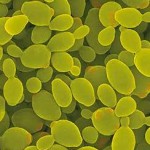Team:Georgia State/Project
From 2010.igem.org
(Difference between revisions)
(→Production of Herpes Symplex B Virus Antigen in Pichia Pastoris) |
(→Degradation of Toluene using Genetically Engineered Cyanobacteria) |
||
| Line 5: | Line 5: | ||
==Pichia Pastoris as a host organism for iGEM== | ==Pichia Pastoris as a host organism for iGEM== | ||
[[Image:Pichia_pastoris.jpg|right]]Pichia pastoris is a methylotrophic yeast used as an alternative host for protein production in addition to Escherichia coli and Saccharomyces cerevisiae. There are several reasons why P. Pastoris is an ideal host organism. Its ability to perform eukaryotic post-translational modifications, high yields of recombinant protein, and its genetic similarity to Saccharomyces cerevisiae are very attractive traits(Cereghino and Cregg, 2000). Because of these reasons, P.pastoris has quickly gained popularity for recombinant protein production. The Georgia State 2010 team believes P. pastoris would be an excellent chassis for the iGEM competition. Our goal is to provide a tool box of parts necessary for the genetic manipulation of this organism. Parts will include a plasmid backbone, several parts providing alternative selectivity options and promoter systems. In addition, our tool box will be used to produce a flu virus antigen in P. pastoris as an example of how this system could be used for vaccine production. We hope our contributions will enable future users to maximize the use and further explore the incredible potential P. pastoris has to offer! | [[Image:Pichia_pastoris.jpg|right]]Pichia pastoris is a methylotrophic yeast used as an alternative host for protein production in addition to Escherichia coli and Saccharomyces cerevisiae. There are several reasons why P. Pastoris is an ideal host organism. Its ability to perform eukaryotic post-translational modifications, high yields of recombinant protein, and its genetic similarity to Saccharomyces cerevisiae are very attractive traits(Cereghino and Cregg, 2000). Because of these reasons, P.pastoris has quickly gained popularity for recombinant protein production. The Georgia State 2010 team believes P. pastoris would be an excellent chassis for the iGEM competition. Our goal is to provide a tool box of parts necessary for the genetic manipulation of this organism. Parts will include a plasmid backbone, several parts providing alternative selectivity options and promoter systems. In addition, our tool box will be used to produce a flu virus antigen in P. pastoris as an example of how this system could be used for vaccine production. We hope our contributions will enable future users to maximize the use and further explore the incredible potential P. pastoris has to offer! | ||
| - | |||
| - | |||
| - | |||
| - | |||
| - | |||
| - | |||
| - | |||
Revision as of 22:33, 6 September 2010

Over the past month, the team has worked diligently in preparing P. pastoris and Cyanobacteria competency, transforming DNA BioBrick parts, and optimizing growth conditions for future transformations. In addition, the group convened for the first annual GSU iGEM Boot Camp to work on team building, understanding the basic concepts, and organizing public relations.
 "
"
